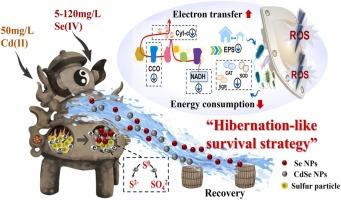基于 "类冬眠微生物生存策略 "的硫磺自养反应器去除高浓度硒(IV)和镉(II)的研究
IF 12.2
1区 环境科学与生态学
Q1 ENGINEERING, ENVIRONMENTAL
引用次数: 0
摘要
从低碳废水中去除亚硒酸盐(Se(IV))和镉(Cd(II))面临着重大挑战。然而,外部有机碳源的添加由于成本高和可能产生二次污染而限制了其应用。本研究介绍了一种“类似冬眠的微生物生存策略”,在硫自养反应器中,以S0作为电子供体,实现了Se(IV)和Cd(II)的高效去除。ⅰ-ⅳ期对5 ~ 120 mg/L Se(IV)和50 mg/L Cd(II)的去除率均大于99 %,硫自养反应器中形成的纳米颗粒可循环利用。x射线光电子能谱分析证实了Se(IV)和Cd(II)的去除途径为生物还原、吸附和生物合成。硫酸根实际浓度与理论浓度之比的减小表明硫自养反应器中硫歧化趋势减弱。自养-异养共生体的形成有利于促进电子传递、物质交换和信息流。硒(IV)和镉(II)胁迫下,微生物有策略地降低代谢活性,以减少额外能量消耗,表现为细胞外DNA、细胞外聚合物质和电子传递系统活性的降低。此外,微生物在保证所需电子通量的前提下,减少了烟酰胺腺嘌呤二核苷酸、细胞色素c和cyt-c氧化酶的分泌。提出了“冬眠样微生物生存策略”来解释硫自养反应器中Se(IV)和Cd(II)的去除,扩大了硫自养在环境工程中的潜在应用。本文章由计算机程序翻译,如有差异,请以英文原文为准。

The removal of high Se(IV) and Cd(II) concentrations in sulfur autotrophic reactor based on the “hibernation-like microbial survival strategy”
The removal of selenite (Se(IV)) and cadmium (Cd(II)) from low-carbon wastewater presents significant challenges. However, the addition of external organic carbon sources is limited in application due to the high cost and potential for secondary pollution. This study introduced a “hibernation-like microbial survival strategy”, enabling efficient removal of Se(IV) and Cd(II) in sulfur autotrophic reactor, with S0 acting as the electron donor. The removal efficiencies of 5–120 mg/L Se(IV) and 50 mg/L Cd(II) were higher than 99 % in phase I–IV, and the nanoparticles formed in sulfur autotrophic reactor were available for recycling. The analysis of X-ray photoelectron spectroscopy confirmed that the removal pathways of Se(IV) and Cd(II) were biological reduction, adsorption, and biosynthesis. The decreased ratio of actual to theoretical sulfate concentrations indicated the weakened sulfur disproportionation trend in sulfur autotrophic reactor. The formation of autotrophic-heterotrophic symbiont was beneficial for promoting electron transfer, material exchange, and information flow. Microorganisms strategically decreased metabolic activity to reduce extra energy consumption under Se(IV) and Cd(II) stress, which was manifested in the decreased extracellular DNA, extracellular polymeric substances, and electron transfer system activity. Furthermore, microorganisms reduced the secretion of nicotinamide adenine dinucleotide, cytochrome c, and cyt-c oxidase on the premise of ensuring the required electron flux. The “hibernation-like microbial survival strategy” was proposed to explain the removal of Se(IV) and Cd(II) in sulfur autotrophic reactor, expanding the potential application of sulfur autotrophy in environmental engineering.
求助全文
通过发布文献求助,成功后即可免费获取论文全文。
去求助
来源期刊

Journal of Hazardous Materials
工程技术-工程:环境
CiteScore
25.40
自引率
5.90%
发文量
3059
审稿时长
58 days
期刊介绍:
The Journal of Hazardous Materials serves as a global platform for promoting cutting-edge research in the field of Environmental Science and Engineering. Our publication features a wide range of articles, including full-length research papers, review articles, and perspectives, with the aim of enhancing our understanding of the dangers and risks associated with various materials concerning public health and the environment. It is important to note that the term "environmental contaminants" refers specifically to substances that pose hazardous effects through contamination, while excluding those that do not have such impacts on the environment or human health. Moreover, we emphasize the distinction between wastes and hazardous materials in order to provide further clarity on the scope of the journal. We have a keen interest in exploring specific compounds and microbial agents that have adverse effects on the environment.
 求助内容:
求助内容: 应助结果提醒方式:
应助结果提醒方式:


